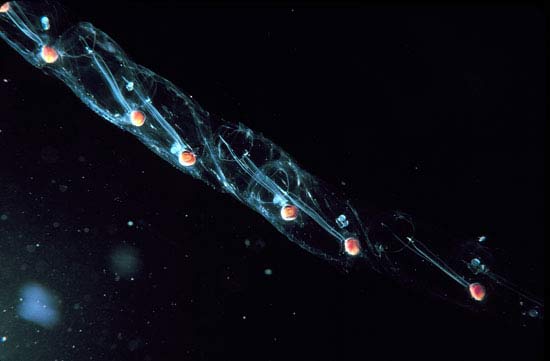Ocean 'Gummy Bears' Fight Global Warming

Swarms of lowly thumb-sized ocean creatures that often resemble chains of transparent Gummy Bears play a critical role in transporting a greenhouse gas deep into the deep sea, scientists report.
The semi-transparent barrel-shaped creatures, called salps, emerge by the billions in groups that occupy as much as 38,600 square miles of the sea surface (about the size of the state of Indiana), Laurence Madin of Woods Hole Oceanographic Institution wrote in a newly published study.
Madin and his colleagues have now estimated that "hotspots" of salps could spell a dead-end for carbon, transporting tons of it daily from the ocean surface to the deep sea and preventing it from re-entering the atmosphere and contributing again to the greenhouse effect and possibly to global warming.
In and out
Scientists have long known that ocean water and marine creatures absorb excess carbon dioxide from the atmosphere, much of which results from the fossil fuels we burn.
Tiny marine plants called phytoplankton extract the carbon from atmospheric carbon dioxide to build their skeletons and shells. Larger ocean animals then eat the phytoplankton. When the animals die or defecate, the carbon dissolves back into the oceans.
Salps are among the larger creatures that eat phytoplankton, consuming up to 74 percent of them from the surface water in a day. The salps then defecate, and their sinking pellets transport up to 4,000 tons of carbon daily to deeper water.
Sign up for the Live Science daily newsletter now
Get the world’s most fascinating discoveries delivered straight to your inbox.
"Salps swim, feed and produce waste continuously," said Madin, who headed up the study recently published in the journal Deep Sea Research. "They take small packages of carbon and make them into big packages that sink fast."
[In a separate study, giant ocean "snot balls" were found to use a different method to same end.]
Round trip
Salps move through water by drawing water in one end and propelling it out the other, sort of like jet propulsion.
Madin and his colleagues at the University of Connecticut and the University of Maryland Center for Environmental Science have stalked a species of salps, Salpa aspera, along the Eastern Seaboard on at least four occasions over the past 30 or so years. They collected salps with trawling nets and by hand while scuba diving and found that this species can form dense swarms that last for months. With video and other lab methods, they were able to estimate the size of swarms, their feeding rate, their defecation rate and their impact on the local population of phytoplankton.
Previous research showed that these salps swim to dark, deep ocean recesses by day, usually around 2,000 to 2,600 feet deep, and back up to the surface at night—something called vertical migration.
"At the surface, salps can feed on phytoplankton," Madin said. "They may swim down in the day to avoid predators or damaging sunlight."
Surfacing at night allows them to come together for reproduction and multiply quickly when food is abundant, he said.
Deep deposits
The result is that salps release fecal pellets in deep water, where few animals consume them, making them efficient transporters of carbon away from the atmosphere.
Salp pellets can sink even more than half a mile per day. And when they die, salp bodies take carbon down with them, sink rapidly up to a quarter mile a day.
Different species of salps have also been documented in recurring dense swarms in waters off Australia, New Zealand, Japan, South Africa, the southeastern United States, the Western Mediterranean Sea, the eastern North Atlantic Ocean and the Southern Ocean.
Scientists still don't know how often salp swarms emerge, but it is clear that they can quickly take advantage of sudden blooms of phytoplankton, efficiently feeding on them with their mucus membrane filters and growing rapidly. Swarms can emerge in just a few weeks, to the point where they interfere with fishing, Madin said.
- Gallery: Rich Life Under the Sea
- Mystery Ocean Glow Confirmed in Satellite Photos
- Global Warming or Just Hot Air? A Dozen Different Views
- VIDEO: Goldilocks and the Greenhouse
Hot Topic

What makes Earth habitable? This LiveScience original video explores the science of global warming and explains how, for now, conditions here are just right.
The Controversy
- Global Warming or Just Hot Air? A Dozen Different Views
- Global Warming Differences Resolved
- Conflicting Claims on Global Warming and Why It's All Moot
- Baffled Scientists Say Less Sunlight Reaching Earth
- Scientists Clueless over Sun's Effect on Earth
- Greenhouse Gas Hits Record High
- Key Argument for Global Warming Critics Evaporates
The Effects
- Seas Rise
- More Wildfires
- Deserts to Grow
- Greenland Melts
- Ground Collapses
- Glaciers Disappear
- Allergies Get Worse
- Animal DNA Changing
- Animals Change Behavior
- Rivers Melt Sooner in Spring
- Increased Plant Production
- Hurricanes Get Stronger
- Lakes Disappear
The Possibilities
- More Rain but Less Water
- Ice-Free Arctic Summers
- Overwhelmed Storm Drains
- Worst Mass Extinction Ever
- A Chilled Planet
Strange Solutions
Robin Lloyd was a senior editor at Space.com and Live Science from 2007 to 2009. She holds a B.A. degree in sociology from Smith College and a Ph.D. and M.A. degree in sociology from the University of California at Santa Barbara. She is currently a freelance science writer based in New York City and a contributing editor at Scientific American, as well as an adjunct professor at New York University's Science, Health and Environmental Reporting Program.











